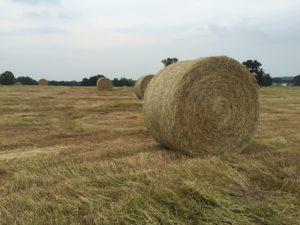Nitrogen is an essential plant nutrient. Plants readily take up and use two forms of soil nitrogen, ammonium (NH4+) and nitrate (NO3-). Other forms of nitrogen must be converted to one of these compounds before plants can utilize them directly for plant growth.
Sources of Nitrogen:
Plants such as legumes “make their own” nitrogen. A symbiotic (positive for both parties) relationship between a legume and rhizobium bacteria develops and the bacteria “fix” nitrogen out of the atmosphere and convert the nitrogen gas into forms that can be used by the plant.
Other sources of soil nitrogen include: mineralization of organic matter and nitrogen released as plant residues break down in the soil. Animal manure is a good source of nitrogen as well.
Ammonium nitrate is 34% nitrogen by weight. The volatilization losses from surface applied ammonium nitrate are usually quite small, especially compared to urea-based fertilizers. Ammonium nitrate can be broadcast as a dry product to the soil surface.
Ammonium sulfate is 21% nitrogen with little or no surface volatilization loss. One disadvantage is that it is the most acidifying form of N fertilizer (will decrease soil pH). It requires approximately 2 to 3 times as much lime to neutralize the same amount of acidity as formed by other common nitrogen sources.
Urea is a popular as a nitrogen fertilizer compared to other forms because of its relatively high nitrogen content (46% of total weight is nitrogen). Surface volatilization can be a problem if the urea is not placed in contact with the soil and it is dry for several days after spreading. Rate of volatilization depends on moisture level, temperature and surface pH of the soil. Temperatures greater than 50 degrees Fahrenheit and pH’s greater than 6.5 significantly increase the rate of urea conversion to ammonia gases.
Urea-Ammonium nitrate (UAN) is a solution of urea and ammonium nitrate containing between 28 and 32% N. Since half of the solution is urea there is a risk of surface volatilization with UAN. Liquid UAN is popular because of the versatility of a liquid source..can often be mixed with herbicides or insecticides. (Refer to pesticide labels before mixing with UAN)
Some fertilizers that are applied as a source of phosphorus also contain significant levels of nitrogen.
Diammonium phosphate (DAP) contains 18% N and 46% P2O5
Monoammonium phosphate (MAP) contains 11% N and 52% P2O5
Nitrogen is a primary plant nutrient along with phosphorus and potassium. Don’t forget to follow Soil Testing Form recommendations to ensure your forages have all the nutrients they need to be productive and persistent.
Vanessa Corriher-Olson
Professor, Forage Extension Specialist
Soil & Crop Sciences
Overton, TX
Texas A&M AgriLife Extension Service
Texas A&M University System
